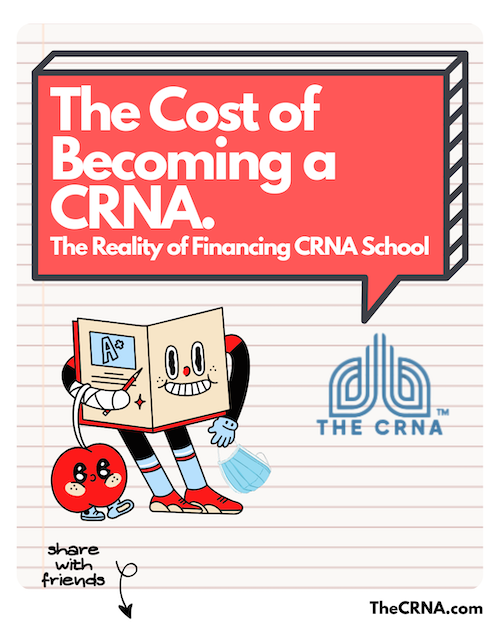Becoming a Certified Registered Nurse Anesthetist (CRNA) is a rewarding career path, but the price tag can be overwhelming. Tuition alone can range from $60,000 to over $200,000, depending on the program. When you add in the cost of books, supplies, and lost income from not being able to work full-time during school, the financial commitment becomes even greater.
That said, the investment often pays off. CRNAs are among the highest-paid nursing professionals, with average salaries exceeding $200,000 annually. While the upfront cost can feel intimidating, the long-term return on investment makes CRNA school one of the most financially promising advanced nursing paths.

The Challenge
Full-time rigor leaves little room to earn while you learn.
- CRNA programs are full-time and highly demanding, often lasting 2.5 to 3 years with little break.
- Clinical rotations plus graduate-level coursework leave little time for employment or side hustles.
- Most programs explicitly discourage or restrict working during school, citing the need for focus on patient safety and academic performance.
- Students must carefully balance tuition, housing, transportation, food, and healthcare costs while not drawing a full-time paycheck.
Many students report the transition to CRNA school as one of the most difficult financial adjustments of their careers. Unlike nursing school, which can sometimes be balanced with part-time work, anesthesia training leaves almost no flexibility for outside income. Preparing financially before enrollment can make this transition less stressful.
Common Financial Realities
High costs now, strong earning potential later.
- Debt is normal for most CRNA students, with many graduating with six-figure balances.
- The cost of attendance frequently exceeds $150K+ when tuition, fees, and living expenses are combined.
- Starting salaries typically range from $175K–$350K+, depending on region, hospital system, and practice setting.
- With disciplined repayment strategies, loans can be eliminated in 2–5 years, often much faster than for other advanced degrees.
CRNAs are among the highest-paid advanced practice nurses, making the return on investment attractive despite the initial debt. However, students should prepare for temporary financial discomfort during the program. Planning ahead with savings or a clear repayment roadmap helps ensure financial stability post-graduation.
Loan Options Explained
Understand your funding stack before you enroll.
- Federal Unsubsidized Loans: Provide $20,500 per year, with a maximum of $200K across professional degrees. Interest accrues while in school.
- Grad PLUS Loans: A popular option historically used to cover additional costs. These will be eliminated after July 2026, creating a funding gap for future students.
- Private Loans: Often necessary to fill the gap. Interest rates and terms vary widely depending on credit score and whether a cosigner is available.
- Repayment:
- Federal loans typically begin repayment 6 months after graduation.
- Private loans may offer limited grace periods or require interest-only payments during school.
With the end of Grad PLUS loans, students should expect to rely more heavily on private lenders unless new federal programs are introduced. This makes understanding terms like fixed vs. variable interest rates, deferment options, and repayment plans even more critical.
Cost of Living Strategies
Lower your burn rate to borrow less.
- Choose programs in affordable cities when possible. A program in a major metropolitan area may cost double what it does in a smaller city.
- Share housing or consider renting a modest apartment close to clinical sites to minimize commuting costs.
- Place excess loan disbursements in high-yield savings accounts to create an emergency buffer.
- Avoid lifestyle creep—resist the temptation to upgrade cars, apartments, or luxury purchases until loans are under control.
Some students save thousands of dollars by relocating to lower-cost regions or by living with family during school. Others reduce expenses by meal prepping, carpooling, or using student discounts wherever possible.
Working During CRNA School
Limited work is possible early—rare later.
- Didactic year: Some students manage occasional PRN shifts, especially on weekends or holidays.
- Clinical years: Nearly impossible to sustain employment, as students often spend 40+ hours in clinical plus additional time studying.
- Some programs require students to sign contracts explicitly prohibiting outside work to ensure safety and focus.
- Working full-time risks academic failure, burnout, and dismissal from the program.
Students who attempt to work often find their grades slip or their mental health suffers. It is strongly advised to save beforehand or rely on loans rather than jeopardize the program’s completion.
Alternative Income & Support
Build a cushion and seek aligned incentives.
- Take travel nursing contracts before school to maximize savings.
- Seek employer sponsorships or sign-on bonuses in exchange for post-graduation employment commitments.
- Apply for scholarships and federal aid programs such as HRSA and Nurse Corps, which may offer partial loan repayment.
- Use credit cards or personal loans as last-resort emergency support only.
Creative financial planning, like negotiating relocation stipends or agreeing to work in underserved areas for loan forgiveness, can help reduce the debt burden. Students who enter school with six months of living expenses saved often report far less stress throughout their programs.
Key Takeaways
Short-term sacrifice, long-term ROI.
- CRNA school is a major financial investment, but one with a powerful return.
- Temporary debt and financial discomfort are part of the process for most students.
- Prioritize academic success and clinical performance—short-term side income is rarely worth the risk.
- With careful planning, disciplined repayment, and a strong salary post-graduation, loans can be paid off quickly and financial freedom achieved.
Ultimately, the financial journey of CRNA school is one of sacrifice followed by reward. Students who prepare early, borrow strategically, and live frugally during school often emerge in a far stronger financial position than peers in other professional programs. The key is to view the debt not as a burden but as a calculated investment in a career with stability, autonomy, and high earning power.


